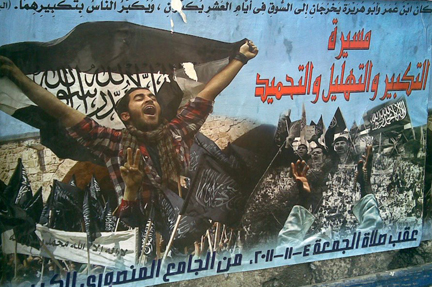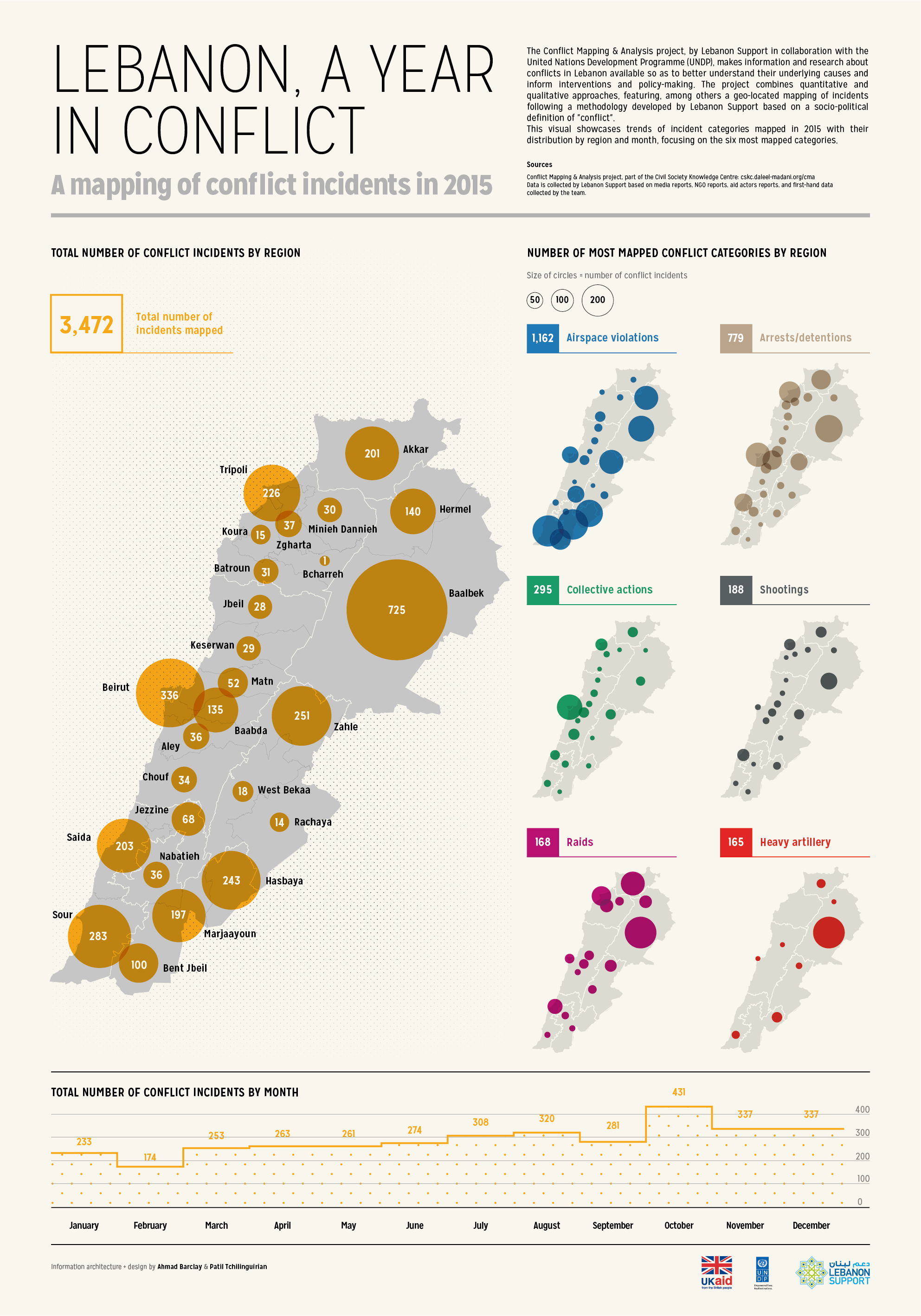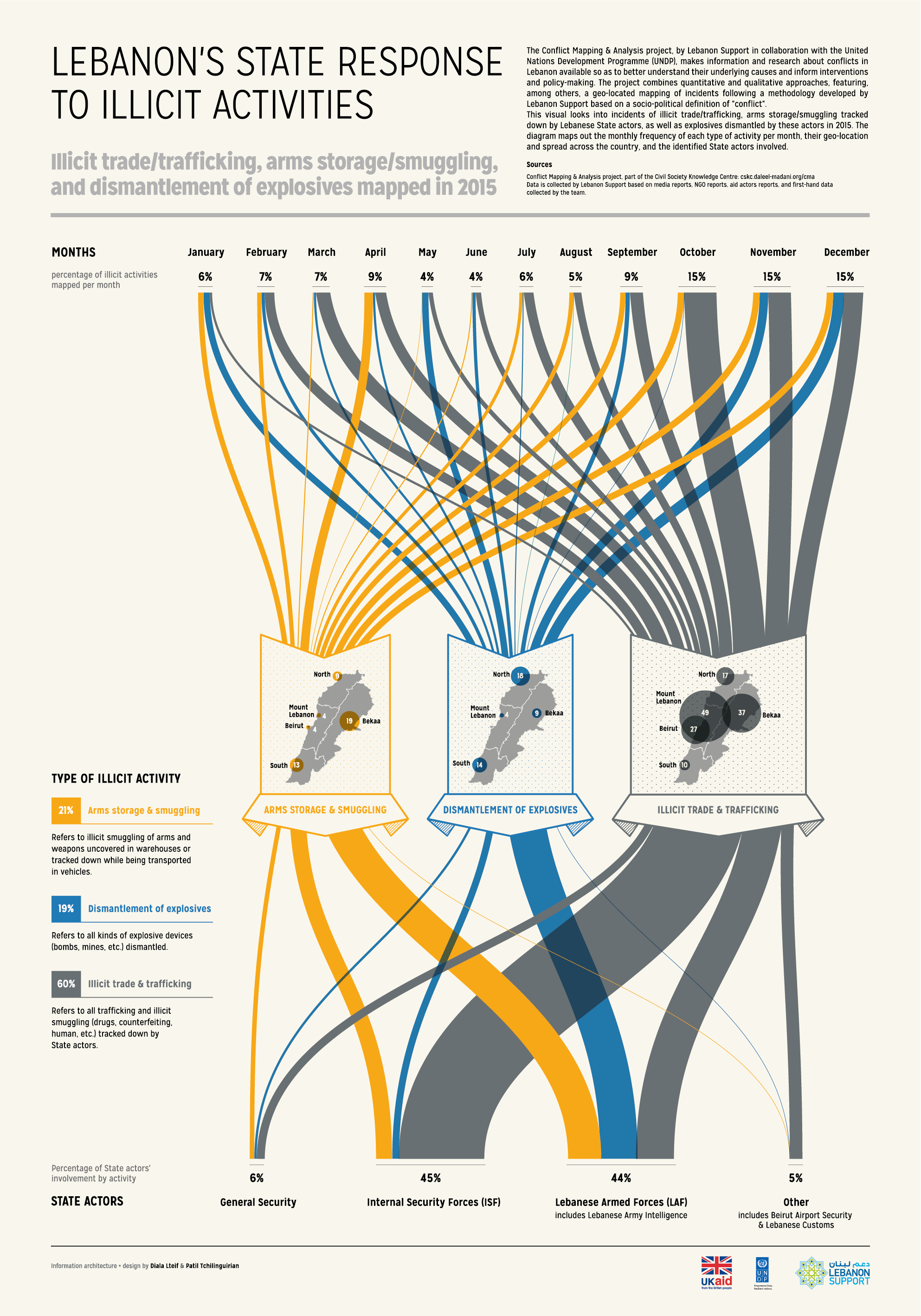Conflict Analysis bulletin, issue 2, April 2016


Issue 2, April 2016 - العدد رقم ٢، أيار ٢٠١٦
About the bulletin
The Conflict Analysis bulletin, part of the Conflict Mapping & Analysis project (CMA) is an initiative by Lebanon Support, with the support of the United Nations Development Programme (UNDP), available on the Civil Society Knowledge Centre (CSKC), Lebanon Support’s knowledge platform. It aims to make available and accessible information and research about conflicts in Lebanon, in order to better understand their underlying causes, and inform interventions and policy-making.
This bulletin highlights a selection of the latest publications on the CMA’s page, including papers, articles, reports, visuals, and interactive content such as a geo-located mapping of conflict incidents and timelines.. Additionally, the bulletin includes visualisations of main conflict trends during the last quarter.
Defining Conflict:Going beyond the view of conflict through a security framework associated with belligerency and violence, Lebanon Support upholds that conflict is of a socio-political nature. It thus sheds light on dynamics underlying a broad spectrum of violent and non violent contentions including social movements, passing by conflicts opposing minorities (ethnic, religious or sexual among others) as well as local, national or regional actors’ policies. Read more and check the interactive conflict map here.
1. Conflict Trends in Lebanon in 2015
Having started its mapping in June 2014, Lebanon Support has decided to take advantage of the fact that it has a year’s worth of data, from 1 January 2015 till 31 December 2015.
The following three visuals have been produced in this vein.
Lebanon, a year in conflict. A mapping of conflict incidents in 2015
This visual gives a broad overview of mapping trends in 2015. It showcases incident categories mapped in 2015 with their distribution by region and month, focusing on the six most mapped categories.
The most mapped category, by far, is “Airspace Violations”, with over 1,000 incidents mapped. This category mostly involves Israeli Military violating the sovereignty of Lebanese airspace territory and can be considered an invisible conflict: it happens at a very frequent rate but is often ignored and not taken into consideration when issues of conflict in Lebanon are addressed.
“Arrests/Detentions” and “Raids” are respectively the second and fifth most mapped categories (779 and 168 mapped incidents) and highlight the presence and strength of State actors in spite of assumptions of “weak” or “absent” State.
It is also notable that the third most mapped category is “Collective actions”, which denotes the many mobilisations of people in Lebanon whether concerning the waste management conflict (see relevant timeline here), the EDL conflict (see relevant timeline here, and relevant actor profile here), the tenants/renters protests, protest of families of kidnapped soldiers (see investigative article here), etc.
Armed conflicts in Lebanon. Clashes/armed conflict incidents in 2015
This visual gives an overview of mapped “Clashes/Armed Conflict” incidents. This is a category used whenever two parties/groups are involved in armed back and forth exchanges. The heatmap shows where these clashes have taken place, whereas the timeline visualizes where and when these clashes have intensified. It is apparent that the majority of these incidents has taken place in Arsal.
The mapping of identified clashing actors allows to understand who has been involved in such clashes, whether State or non-State actors. For example, fighting in Arsal has involved the Lebanese Armed Forces (LAF) (see actor profile here) against militant groups like Islamic State (see actor profile here) and al-Nusra Front (see actor profile here), there were also clashes between Hezbollah and these militant groups, as well as inter-fighting between IS, al-Nusra, and Fateh Army.
Lebanon’s State response to illicit activities. Illicit trade/trafficking, arms storage/smuggling, and dismantlement of explosives mapped in 2015
This infographic focuses on the State’s response to the following illicit activities:
- “Illicit Trade/Trafficking/Smuggling” relevant to drug trafficking, counterfeiting of documents, or smuggling and trafficking of humans, and which is the most mapped type of illicit activity (60%);
- “Arms Storage/Smuggling” which refers to illegal trade of weapons or storage of large amounts of arms;
- and “ Dismantlement of Explosives” which denotes the efforts of State actors in dismantling any explosive devices or in demining.
The diagram maps out the frequency of each type of mapped activity per month, with the thickness of the funnel being directly related to the percentages of these activities. It shows their spread across the territory with maps showing their geo-locations. It finally links to the State actors that were involved in the response, whether it was an arrest or a raid, highlighting how the Internal Security Forces (ISF) and Lebanese Armed Forces (LAF) are taking the lead in responding to such activities. The visual highlights how the ISF are mostly involved in tracking down “Illicit Trade/Trafficking/Smuggling”, while the LAF’s efforts target all three types of illicit activity almost equally.
This infographic serves to show that in spite of a security situation deemed unsafe, State actors have in fact been responding to illicit activities that can be linked to conflicts of power and governance, or involving militant groups.
2. Featured papers within the Conflict Mapping & Analysis project

By Marianne Madoré | March, 2016
Since early 2011, the few episodes of violence involving refugees in Lebanon have been covered extensively. Yet, given the high numbers of displaced people, the proximity of the battles, and the pre-existing pressures in Lebanon, one could have expected many more clashes to take place. This article focuses on the densely populated municipality of Bourj Hammoud, where the proportion of registered Syrian refugees has reached a fifth of the local population without leading to any major violent episodes. Based on extensive ethnographic study, this article explains the social stability that prevailed by highlighting mechanisms of regulation and control, the management of the influx of refugees by local actors, and the agency of the refugees themselves in the settlement process. Read more

Prisms of Political Violence, ‘Jihads’ and Survival in Lebanon’s Tripoli
By Estella Carpi | December, 2015
In the framework of the recruitment of Syrian and Lebanese fighters combating today in Syria, this paper aims to further problematise the processes in which individuals decide to disrupt their ordinary lives to engage with “Jihadist” armed groups. Such processes are frequently studied and tackled by government programmes and NGO practices aimed at the “rehabilitation” of former fighters in various countries ranging from Muslim majority states to European or North American states. Likewise, some terrorism scholars still tend to trace a linear path to identify the social and psychological causes which push individuals to join militant groups, and trace the causes which, in some cases, lead to subsequent disengagement from fighting and the ideology involved. This study rather shows the cyclic and changing nature of life choices and circumstances which influence Jihadist fighters and supporters. By doing so, it embraces the scholarly approach according to which “extremist” armed groups should be studied and understood as any conventional social group. In specific, this primary research is based on ten in-depth interviews conducted in the northern Lebanese city of Tripoli with Syrian and Lebanese ex-fighters, and with sympathisers of the so-called "Jihadi ideology" who never took up weapons. To interpret the narratives I collected, I will intentionally draw on both critical and mainstream security-focused bodies of literature on political violence, “radicalisation”, and extremism. While the experiences recounted by the ex fighters will be analysed through the two constructed categories of contingency and intentionality, the Jihadist supporters who never joined an armed group rather point to how there is no linear and unilateral progression from “extremist” beliefs to violence. The survival of such forms of political violence, ultimately, challenges the survival of politically biased knowledge and the programmes that the latter informs. Read more
3. Featured investigative article

Is justice for everyone? Arbitrary detention and torture of Islamists in Lebanon
By Camille Lons | March, 2016
Although it is difficult to clearly establish the link between “Islamists” and high rates of arbitrary detention and torture, the security and political context surrounding the issues make Islamists a particularly vulnerable population to arbitrary arrest, detention, unfair sentences, torture and ill-treatment. This article aims to understand the special circumstances of the “Islamists" case, and demonstrate the wide range of Human Rights violations perpetrated under the protection and guise of preserving State security. It is based on a series of interviews with lawyers, representative of Human Rights NGOs and a former detainee. Read more.
عن النشرة
إنّ نشرة تحليل النزاعات، وهي جزء من مشروع مسح النزاعات وتحليلها (CMA)، هي عبارة عن مبادرة أطلقها مركز دعم لبنان بدعم من برنامج الأمم المتحدة الإنمائي ووضعها على منصة المعرفة خاصّته، أي بوابة المعرفة للمجتمع المدني. تهدف هذه النشرة إلى إتاحة المعلومات والبحوث حول النزاعات في لبنان بغية تحسين فهم أسبابها الكامنة والتأثير في عملية بلورة التدخلات ووضع السياسات.
تسلِّط هذه النشرة الضوء على مروحة منتقاة من أحدث المطبوعات والمنشورات على صفحة مشروع مسح النزاعات وتحليلها، بما في ذلك الأوراق، والمقالات، والتقارير، والمواد البصرية، والمحتوى التفاعلي، مثل مسح النزاعات وتحديد موقعها الجغرافي وإطارها الزمني. هذا وتتضمّن النشرة تصوّرات مرئية لاتجاهات النزاعات الأساسية خلال الربع الأخير.
تعريف النزاع: لا ينظر مركز دعم لبنان إلى العنف من منظور إطار أمني تصاحبه أعمال العنف والعدوانية، بل يتعداه ليتمسّك بموقفه القائل إنّ النزاع هو ذات طبيعة اجتماعية وسياسية. وبالتالي، يضيء المركز على الديناميات التي تحيط بمروحة واسعة من الخلافات العنيفة وغير العنيفة، بما فيها الحركات الإجتماعية مروراً بالنزاعات التي تتورّط فيها الأقليات (الإثنية أو الدينية أو الجنسية من ضمن أخرى)، بالإضافة إلى سياسات الأطراف الفاعلة المحلية أو الوطنية أو الإقليمية. إقرأ المزيد وتصفّح خريطة النزاعات التفاعلية هنا.
1. إتجاهات النزاعات في لبنان في العام 2015
إرتأى مركز دعم لبنان، هو الذي باشر مسح النزاعات في حزيران/ يونيو 2014، الإستفادة من البيانات التي راكمها على مدى عام، وتحديداً إعتباراً من 1 كانون الثاني/يناير 2015 لغاية 31 كانون الأول/ديسمبر 2015.
فكان أن أبصرت المواد البصرية الثلاث التالية النور.
لبنان، النزاعات في عام. النزاعات الممسوحة في العام 2015
تقدِّم هذه المادة البصرية لمحةً عامةً وشاملةً عن اتجاهات المسح في العام 2015. فتضيء على فئات الحوادث الممسوحة في العام 2015 والمُبيَّنة على الخرائط بحسب توزيعها المناطقي والزمني ومع تركيز على الفئات الست الأكثر تواتراً.
طغت فئة "إنتهاكات المجال الجوي" على الخرائط بلا منازع، مع مسح أكثر من ألف حادث من هذا النوع. وتشتمل هذه الفئة بشكل خاص على انتهاك الجيش الإسرائيلي سيادة المجال الجوي اللبناني، في ما يمكن تصنيفه في خانة النزاعات غير المرئية. والمقصود بها تلك الحوادث التي يتكرّر وقوعها لكنْ غالباً ما يتم تجاهلها عند استعراض النزاعات في لبنان.
أما "حالات الإعتقال/الإحتجاز" و"المداهمات" فجاءت في المرتبة الثانية والخامسة (مع مسح 779 و168 حادثاً على التوالي)، الأمر الذي يضيء على وجود الأطراف الفاعلة الحكومية وقوتها على الرغم من الفرضيات القائلة "بضعف" الدولة أو "غيابها".
وفي المرتبة الثالثة من حيث الفئة الأكثر تبياناً على الخرائط حلّت "التحركات الشعبية"، في إشارة إلى المرات الكثيرة التي نزل فيها الناس إلى الشارع إحتجاجاً إما على خلفية النزاع المتصل بإدارة النفايات (راجع الإطار الزمني ذات الصلة هنا) أو بمؤسسة كهرباء لبنان (راجع الإطار الزمني ذات الصلة هنا ولمحة عن الأطراف المعنية هنا) أو تحركات المستأجرين/المالكين وعائلات العسكريين المخطوفين (راجع التقرير الإستقصائي هنا)، إلخ.
النزاعات المسلحة في لبنان.الإشتباكات/النزاعات المسلحة في العام 2015
تقدِّم هذه المادة البصرية لمحة عن الحوادث الممسوحة ضمن فئة "الإشتباكات والنزاعات المسلحة". ويندرج فيها كلّ اشتباك مسلّح أو تبادل لإطلاق نار بين طرفين أو مجموعتين. يظهر الرسم البياني الملوَّن أماكن وقوع هذه الإشتباكات، في حين يصوِّر الإطار الزمني أين ومتى زادت الإشتباكات حدة. من الواضح أنّ غالبية هذه الحوادث وقعت في عرسال.
في الواقع، يتيح مسحُ الأطراف المتناحرة معلومة الهوية، تحديدَ الجهات المتورِّطة في مثل هذه الإشتباكات، أمنضوية كانت تحت لواء الدولة أو خارجة عن سيطرتها. ففي عرسال مثلاً، دارت اشتباكات بين الجيش اللبناني (راجع لمحة عن هذا الطرف هنا) ومجموعات مسلحة ناشطة، مثل الدولة الإسلامية (راجع لمحة عن هذا الطرف هنا) وجبهة النصرة (راجع لمحة عن هذا الطرف هنا). كذلك، سُجِّلت اشتباكات بين حزب الله وهذه المجموعات المسلحة الناشطة، فضلاً عن التقاتل بين الدولة الإسلامية والنصرة وجيش الفتح.
تصدي الدولة اللبنانية للأنشطة غير المشروعة الممسوحة في العام 2015. الإتجار غير المشروع وتخزين الأسلحة وتهريبها وتفكيك المتفجِّرات
يركِّز هذا الرسم البياني على استجابة الدولة للأنشطة غير المشروعة التالية:
يراد "بالإتجار غير المشروع" الإتجار بالمخدرات أو تزوير المستندات أو الإتجار بالبشر وتهريبهم وهو النشاط الأكثر تبياناً على الخرائط (بنسبة 60%)؛
يشير "تخزين الأسلحة وتفكيكها" إلى الإتجار غير المشروع بالأسلحة أو تخزين كميات كبيرة منها؛
يشير "تفكيك المتفجِّرات" إلى الجهود التي تبذلها الأطراف الفاعلة الحكومية في تفكيك المتفجِّرات أو نزع الألغام.
يوضح الرسم البياني تواتر كلّ نوع من الأنشطة الممسوحة شهرياً، مع تركيز خاص على النسب المئوية لهذه الأنشطة. كما يبيّن توزيعها عبر المناطق، مع تحديد موقعها على الخرائط. وأخيراً، يشير الرسم إلى الأطراف الفاعلة المنضوية تحت لواء الدولة والمعنية بمواجهة هذه الأنشطة، سواء عبر تنفيذ مداهمات أو حملات اعتقال، ولاسيما ما خصّ تولي قوى الأمن الداخلي والجيش اللبناني زمام المبادرة في هذا المجال. فعلى سبيل المثال، يتبيّن من المادة البصرية إنخراط قوى الأمن الداخلي على وجه الخصوص في تعقب أنشطة "الإتجار غير المشروع/التهريب"، خلافاً للجيش اللبناني الذي يستهدف الأنواع الثلاثة كلّها من الأنشطة غير المشروعة بالتساوي تقريباً.
عليه، يظهر هذا الرسم البياني أنّ الأطراف الفاعلة الحكومية، وعلى الرغم من الوضع الأمني الذي يوصف بغير الآمن، تنشط في التصدي للأنشطة غير المشروعة التي قد ترتبط بالنزاعات على السلطة والحكم أو قد تتورّط فيها مجموعات مسلحة ناشطة.
2. أوراق مختارة ضمن مشروع مسح النزاعات وتحليلها

الإستقرار السلمي للاجئين السوريين في ضاحية بيروت الشرقية: فهم أسباب الإستقرار الإجتماعي
بقلم ماريان مادوريه | آذار/مارس 2016
منذ مطلع العام 2011 وحوادث العنف التي تطال لاجئين في لبنان، على قلّتها، تلقى تغطية وافية. لكنْ، وفي ضوء الأعداد المرتفعة للنازحين وقرب المعارك جغرافياً والضغوط التي يرزح لبنان أصلاً تحت وطأتها، كان من المتوقع وقوع اشتباكات أكثر. يركِّز هذا المقال على بلدية برج حمود المكتظة بالسكان والتي لم تُسجَّل فيها أيّ أعمال عنف كبيرة على الرغم من أنّ اللاجئين السوريّين المسجلين فيها يُشكِّلون خُمس عدد السكان. يستند المقال إلى دراسة اثنولوجية وافية ليشرح الإستقرار الإجتماعي السائد، مضيئاً على آليات الرقابة والتنظيم، وإدارة الأطراف الفاعلة المحلية لتدفق اللاجئين، ودور اللاجئين أنفسهم في عملية الإستقرار. إقرأ المزيد

مرآة عاكسة للعنف السياسي و"الجهاد" والبقاء في مدينة طرابلس اللبنانية
بقلم استيلا كاربي | كانون الأول/ديسمبر 2015
مع تجنيد مقاتلين سوريّين ولبنانيّين للقتال في سورية، تهدف هذه الورقة إلى إلقاء المزيد من الضوء على المعضلات التي تنشأ عندما يقرِّر أفرادٌ تغيير مجرى حياتهم العادية والإلتحاق بالمجموعات المسلحة "الجهادية". غالباً مع تدرس البرامج الحكومية والمنظمات غير الحكومية هذه الحالات ضمن عملها الرامي إلى إعادة تأهيل مقاتلين سابقين في دول عدة تتراوح من تلك ذات الغالبية المسلمة إلى أخرى في أوروبا أو أميركا الشمالية. بالمثل، ما زال بعض العلماء المتخصِّصين في قضايا الإرهاب يميل إلى رسم خطّ طولي لتحديد الأسباب الإجتماعية والنفسية التي تدفع بأفراد إلى الإنضمام إلى مجموعات متطرفة ثم، وفي بعض الحالات، إلى فكّ ارتباطهم بالعقيدة والتوقف عن القتال. تُظهر هذه الدراسة الطبيعة الدائرية والمتغيِّرة للخيارات التي يتخذها المرء في حياته والظروف التي تؤثِّر في المقاتلين الجهاديّين وأنصارهم. وبهذه الطريقة، تعتمد المقاربة العلمية القاضية بضرورة دراسة المجموعات المسلحة "المتطرفة" وفهمها باعتبارها مجموعة إجتماعية تقليدية. يستند هذا البحث الأولي على وجه الخصوص إلى عشر مقابلات مُعمّقة أجريت في مدينة طرابلس، شمال لبنان مع مقاتلين سابقين لبنانيّين وسوريّين وأيضاً مع متعاطفين مع "العقيدة الجهادية" لم يحملوا السلاح يوماً. ولتفسير هذه القصص التي جمعتها، سأغرف عمداً من مروحة من الأدبيات التي تتناول العنف السياسي والتطرف والتشدد، أنقدية كانت أو ذات بعد أمني. سيتم تحليل تجارب المقاتلين السابقين من منظور حالات الطوارئ والنية. أما بالنسبة إلى أنصار الجهاديين الذين لم يلتحقوا يوماً بأيّ مجموعة مسلّحة فيظهرون انعدام التدرج الطولي والأحادي من اعتناق المعتقدات "المتطرفة" إلى العنف. لذلك، يأتي بقاء هذه الأشكال من العنف السياسي ليتحدى المعارف المنحازة سياسياً والبرامج التي تقوم عليها. إقرأ المزيد
3. المقال الإستقصائي المختار

هل العدالة للجميع؟ الإحتجاز التعسفي للإسلاميّين في لبنان وتعذيبهم
بقلم كاميل لونس| آذار/مارس 2016
مع أنّه يصعب إقامة رابط واضح بين "الإسلاميّين" وارتفاع معدلات الإحتجاز التعسفي والتعذيب، يتحوّل الإسلاميّون، على خلفية السياق الأمني والسياسي السائد، إلى شريحة مستضعفة معرّضة على وجه الخصوص للإعتقال التعسفي، والإحتجاز، والأحكام المجحفة، والتعذيب، وسوء المعاملة. يهدف هذا المقال إلى فهم الظروف الخاصة التي تلفّ قضية "الإسلاميّين" والإضاءة على الكمّ الهائل من انتهاكات حقوق الإنسان المرتكبة بذريعة حماية أمن الدولة، وذلك بالإستناد إلى سلسلة مقابلات مع محامين وممثِّلين عن منظمات ناشطة في مجال حقوق الإنسان وأحد المعتقلين السابقين. إقرأ المزيد




